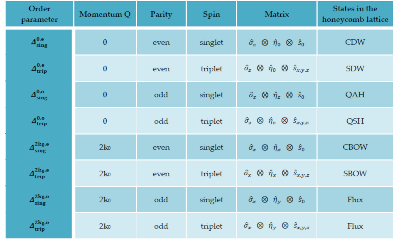Interacting chiral electrons at the 2D Dirac points: a review
Hirata, A. Kobayashi, C. Berthier, and K. Kanoda, Rep. Prog. Phys. 84, 036502 (2021).
The pseudo-relativistic chiral electrons in 2D graphene and 3D topological semimetals, known as the massless Dirac or Weyl fermions, constitute various intriguing issues in modern condensed-matter physics. In particular, the issues linked to the Coulomb interaction between the chiral electrons attract great attentions due to their unusual features, namely, the interaction is not screened and has a long-ranged property near the charge-neutrality point, in clear contrast to its screened and short-ranged properties in the conventional correlated materials. In graphene, this long-range interaction induces an anomalous logarithmic renormalization of the Fermi velocity, which causes a nonlinear reshaping of its Dirac cone. In addition, for strong interactions, it even leads to the predictions of an excitonic condensation with a spontaneous mass generation. The interaction, however, would seem to be not that large in graphene, so that the latter phenomenon appears to have not yet been observed. Contrastingly, the interaction is probably large in the pressurized organic material α-(BEDT-TTF)2I3, where a 2D massless-Dirac-fermion phase emerges next to a correlated insulating phase. Therefore, an excellent testing ground would appear in this material for the studies of both the velocity renormalization and the mass generation, as well as for those of the short-range electronic correlations. In this review, we give an overview of the recent progress on the understanding of such interacting chiral electrons in 2D, by placing particular emphasis on the studies in graphene and α-(BEDT-TTF)2I3. In the first half, we briefly summarize our current experimental and theoretical knowledge about the interaction effects in graphene, then turn attentions to the understanding in α-(BEDT-TTF)2I3, and highlight its relevance to and difference from graphene. The second half of this review focusses on the studies linked to the nuclear magnetic resonance experiments and the associated model calculations in α-(BEDT-TTF)2I3. These studies allow us to discuss the anisotropic reshaping of a tilted Dirac cone together with various electronic correlations, and the precursor excitonic dynamics growing prior to a condensation. We see these provide unique opportunities to resolve the momentum dependence of the spin excitations and fluctuations that are strongly influenced by the long-range interaction near the Dirac points.
(Click figure for a larger image.)

